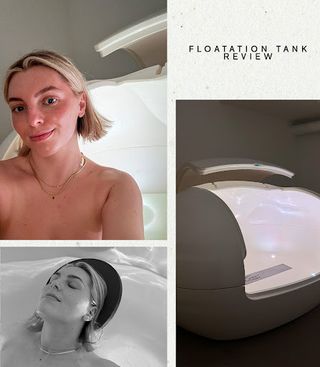You probably already follow Estée Lalonde, and if you don’t, you should. An online content creator, creative director and founder of self-care brand Mirror Water she is known for being a trusted, honest and authoritative voice in the wellness and beauty world, and as a result has created a community that feels understood and listened to. Estée regularly shares her real-life experiences with her followers, so who better to weigh in on some of the biggest beauty and wellness trends of 2024? This month, she tries out floatation tanks. Read her honest review of the wellness treatment below.

(Image credit: ESTEE LALONDE)
What Is Floating?
A flotation tank or sensory deprivation tank is a soundproof, pitch-black tank filled with salt water. It is used for restricted environmental stimulation therapy, aptly abbreviated to REST. Studies suggest that time spent in a tank has benefits such as muscle relaxation, better sleep, improved pain and decreased stress and anxiety.
The water is gently heated and Epsom salts are added to ensure buoyancy so you float more easily. Upon entry, you are cut off from outside stimulation like sound, light and even gravity. As you float, the brain enters into a deeply relaxed state. This kind of therapy is said to produce many effects on the brain, ranging from increased creativity all the way to hallucinations.
What Do I Need?
You don’t really need anything to get ready for the session, not even a swimming costume, as this is an activity to be undertaken alone or with a close partner. Simply arrive and let the floatation tank do the rest. As with any wellness activity, it is important to be well-hydrated before and after your session. I visited Float Hub in Shoreditch, London and they provided me with earplugs, which are essential because the salty water can cause the wax in your ears to harden (gross, I know).
What Is Floating Like?
I was provided with a floating pillow which meant I could fully extend, and the feeling of lying back weightlessly was really calming. The session began with some background lighting and soft music playing for around five minutes before I was submerged into an hour of total quiet and darkness. You can think of this hour as an aide for the deepest meditation, an hour spent only with your thoughts—or absent from them if you can manage it. At the end of the hour, the lights and soft music come back on to let you know that the experience is coming to an end.
How to Make the Most of a Floatation Session
As anyone who meditates will know, it is a practice. And for me, the more you practice, the more rewarding it can become. As such, if you haven’t meditated in a while, I would recommend doing some in the days or weeks leading up to your float to help make the most of your experience on the water.
When you enter the water, don’t touch your face. It’s no big deal if you do, but water droplets or salt drying on the skin could only lead to distractions. I’ve also been told that if the water gets in your eye it can sting quite a bit! Also, be warned that you will be inside a tank with the door closed, so this could be triggering for someone with claustrophobia. I’ll admit I got a little panicked when the lights first turned off, but once I confirmed that the door was easily opened from the inside, my mind was at ease and I could continue entering my meditative state.
Leaving the Floatation Tank
Take your time. Float Hub provides a changing room with hair dryers as well as a relaxation room with tea. You might find it takes a while to cool down, so take your time and remain in that relaxed state before you leave the facility. As you’ve been lying in salty water for some time, you might notice your skin is a little dry, so it’s time for a shower and rehydration with a moisturising body product. The same goes for your hair—you’ll want to make sure you thoroughly wash out all the salt after your session.
Overall Thoughts
I loved my floatation experience because it allowed me to fall into a deeply meditative state. I was lucky to be doing it on a Saturday morning because a drawback would be having wet hair if you were trying to fit it into a busy day of plans. I’d really recommend trying floatation, possibly as something to work towards if you’re on a journey with meditation.
Read the original article here